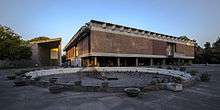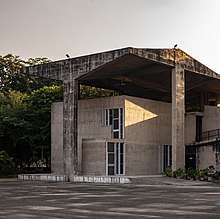Government Museum and Art Gallery, Chandigarh
Government Museum and Art Gallery, Chandigarh, is a premier museum of North India having collections of Gandharan sculptures, Pahari and Rajasthani miniature paintings. It owes its existence to the partition of India in August, 1947. Prior to the partition, the collections of art objects, paintings and sculptures were housed in the Central Museum, Lahore, the then capital of Punjab.
Arts Museum (one of the three museums located one the premises) | |
 Location of Government Museum and Art Gallery in India | |
| Established | May 6, 1968 |
|---|---|
| Location | Chandigarh, India |
| Coordinates | 30°44′56″N 76°47′15″E |
| Type | Art Museum, Architecture Museum, Natural History Museum |
| Collection size | Approx. 10,000 artefacts[1] |
| Architect | Le Corbusier |
| Owner | Chandigarh Administration |
| Website | chdmuseum.nic.in |

After partition, the division of collections took place on April 10, 1948. Sixty percent of objects were retained by Pakistan and forty percent collection fell in the share of India.
The museum was inaugurated on 6 May 1968 by Dr. M. S. Randhawa, the then Chief Commissioner of Chandigarh.
History
The Government Museum and Art Gallery was designed by the Swiss born French architect, Le Corbusier along with his associate architects namely Manmohan Nath Sharma, Pierre Jeanneret and Shiv Dutt Sharma.[2] The design was completed during the period of 1960-62 and construction took place between 1962 and 1967. It is part of the three museums designed by Le Corbusier, the other two being Sanskar Kendra, Ahmedabad and National Museum of Western Art, Tokyo.
Building
The building is a museum and art gallery which regularly conducts art acquisition programs for expansion. Envisaged as a vehicle for transmission of knowledge in the Second Five Year Plan and the National Education Policy, it serves as a unique cultural and historical resource for the region. Having significant collection of Gandhara sculptures, Pahari miniature painting and contemporary Indian art, it is regularly visited by tourists, artists, scholars and students. Researchers, architects and scholars on Le Corbusier and Modernization are also frequent visitors to the building and its surrounding. They ensemble to study its architectural values as it represents the series of museums designed by Le Corbusier. The pivoted entrance, metal panelled door, fixed furniture, display systems, exposed concrete sculpturesque gargoyles are symbolic of the prevailing style of Chandigarh's architecture. The mural in the museum reception area executed by one of India's finest contemporary artists, Satish Gujral adds colour to the otherwise stark exposed concrete building.
The museum library is a rich repository of books on subjects of art, architecture and history of art. A special section is dedicated to Dr. M. S. Randhawa, containing archival records of his correspondence on the Making of Chandigarh, available to scholars in a digitized version. The adjacent auditorium serves as a lecture hall for extended activities of the museum such as lectures, film screenings and cultural events. The interior detailing of the auditorium represent the Modernist tradition that was introduced in Chandigarh by Le Corbusier.
The building is divided into three levels. The first level is 33,000 sq ft comprising the Deputy Curator's office, museum shop, reception, textile section, child art gallery, exhibition hall, reserve collection stores, conservation laboratory and auditorium. Level 2 is 23,000 sq ft and comprises exhibition space for sections on Gandhara sculpture, Indian miniature paintings, stone and metal sculpture, coins and Indian contemporary art. Level 3 is 6,500 sq ft and has the library, Chairman's room, and Gandhara sculptures’ reserve collection store.
The museum serves as a means of repository of cultural history of the region. It is open for public from Tuesday to Sunday, from 10:00 AM to 4:40 PM, and is closed on Monday and national holidays. The entry ticket is ₹10 and camera ticket is ₹5. It has a free entry for organised school groups and senior citizens. Facilities such as wheel chairs for the physically challenged are also provided. The auditorium is available at low fees for cultural and educational events as it also serves as the exhibition hall for temporary exhibitions to artists.[3]
Collection

The beginning of the collection can be traced to the partition of India in 1947 when 40% of the collection of the Central Museum, Lahore became the share of the country. A significant part of this share was the Gandhara sculptures. The collections received in April, 1949 from Pakistan were first housed in Amritsar, then Shimla, Patiala and were finally shifted to Chandigarh upon the inauguration of the museum in 1968. Over a period of time, Dr. M. S. Randhawa added Pahari miniature paintings, modern and Indian contemporary art, so that by the time the collection was displayed in the current building designed by Le Corbusier, it was at par with the leading museums of North India. The collection can be divided into the following categories:
Gandhara sculptures
.jpg)
.jpg)
.jpg)
The museum has many different sculptures of Buddha. In some sculptures Buddha has long, open hair, while in some he has a mustache with curled hair lock. In earlier days the followers of Buddha used to worship symbolic representations of Buddha. These representations included representative foot print of Buddha or a Chakra. Later, when the followers wanted to portray Buddha in human form, they portrayed him in a beautiful Greek god-like form. This can be attributed to the Indo-Greek influence in that era.
Metal sculptures
Stone sculptures
Numismatics
Textiles
Decorative art
Pottery
Manuscripts
Modern and Indian contemporary art

Other wings of the museum
- Natural History Museum, Sector 10, Chandigarh
- Chandigarh Architecture Museum, Sector 10, Chandigarh
- National Gallery of Portraits, Sector 17, Chandigarh
- International Dolls Museum, Sector 23, Chandigarh
References
- "About Government Museum and Arts Gallery, Chandigarh". Chandigarh Tourism. Retrieved 12 April 2018.
- http://chdmuseum.nic.in/architecture.html
- "Official Museum Website". Archived from the original on 23 May 2017. Retrieved 1 January 2020.
External links
| Wikimedia Commons has media related to Government Museum and Art Gallery, Chandigarh. |